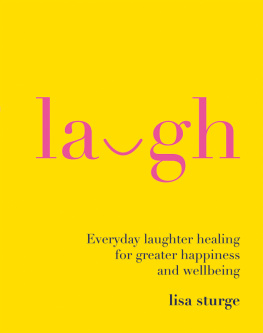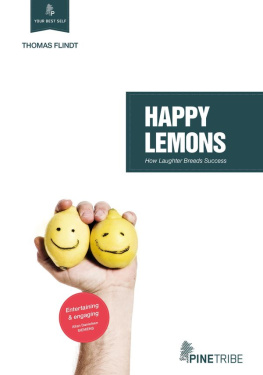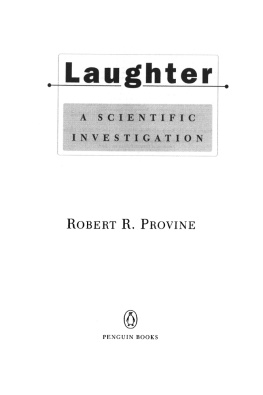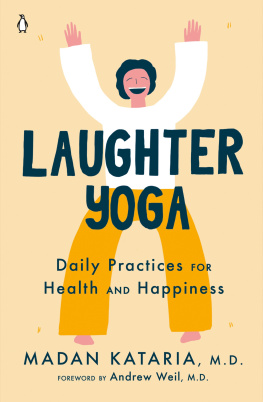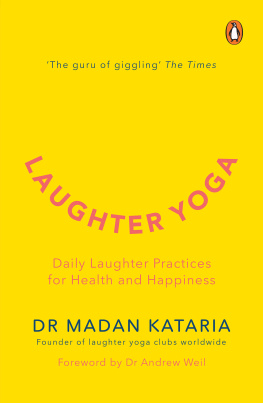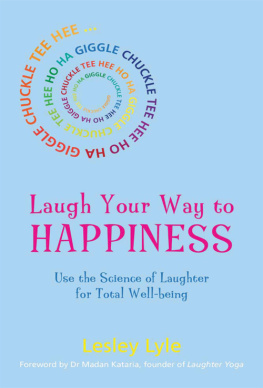CONTENTS
Laughter is a language that everyone understands. Sharing laughter with others bringsa deep sense of connection and belonging, immersing us in the present moment. Laughterenables us to communicate joyfully, to release stress and to experience deep relaxation.
In this book we are encouraged to find inventive ways of bringing laughter into ourlives as a deliberate choice; instead of waiting for laughter to arrive, activelychoose to laugh! When we decide to bring laughter to the body, regardless of moodor circumstance, we free ourselves from the limitations of our conditioned and habitualresponses.
The health benefits of laughter outlined in this book are widespread, with news storiesflooding in every day that verify the extraordinary and powerful effects of laughteron the mind, body and spirit.
I encourage all my students around the world to keep spreading laughter far and wide.Hopefully one day we will see lasting peace in the world through greater awareness,shared love, unconditional laughter and deeper understanding.
Whether you have been laughing for a while or have not laughed in a very long time,this little book provides a treasure trove of creative suggestions to help you alongthe laughter path. I wish you all well for the laughter journey that awaits and mayyou discover unexpected joy and inner peace along the way.
Dr. Madan Kataria
Founder of the Worldwide Laughter Yoga Movement
It may have been...
during a trolley race around the supermarket on a routine weekly shop
when you walked into the kitchen and found your partner grooving to the radio injust an apron
while playing a game of Tag with your Yorkshire terrier
when you glimpsed yourself in the mirror to find an albatross had made a nest inyour hair
when you and your sibling decided to decorate your faces with chocolate warrior paintwhile baking
while singing and dancing with abandon in the office corridor just as your boss walkedthrough the door
watching your favourite comedian in a live stand-up show in-between loud screamson the scariest roller coaster ever
during a laughter club session where you ended up rolling around on the floor withothers in fits of giggles
when you and your friend suddenly laughed for no apparent reason at all and thenfound yourselves unable to stop
THERE ARE A MULTITUDE OF REASONS WHY WE LAUGH.
Laughter can surprise us, coming from nowhere, throwing us into convulsions of mirth.During the most serious of events we can become overwhelmed with a burning desire to laugh wildly, clutching our heaving sides till they ache and hanging on to respectabilityby our fingernails.
So where did laughter come from and how did it evolve?
Laughter is a bridge between people. It enables us to express joy and playfulnessand to share our delight with others.
Laughter encourages us to be more of who we are, rather than who we think we shouldbe. It is an ancient, free tool that has been around for millions of years; laughteris an instant equaliser, a shock absorber and a community builder.
The multiple benefits of laughter can have a wide ranging impact; strengthening ourrelationships, improving our health and increasing our efficiency in the workplace.Laughter brings relaxation and refreshment to everyday activities; it frees us fromour habitual patterns and makes us glow from the inside out. Laughter reminds usto stop and smell the roses, then to laugh when a greenfly crawls up our nostril.
Even if we have not laughed for a really long time, laughter is a skill that canbe re-learnt and integrated into our everyday world, sprinkling joy and sustenanceover all.
Laughter is a joyful embrace of the unexpected, frustrating and glorious. Laughteris a celebration of life. Lets laugh!
HOW DID LAUGHTER EVOLVE?
Laughing is an ancient, universal communication tool that has been in existence forat least ten million years. It originated during play within primate groups: todaychimpanzees, gorillas, orangutans and bonobos all make laughter sounds when tickled.
Laughter evolved before speech as a way of communicating and strengthening bondswithin families of primates. As the sounds developed further, they became a way ofgrooming at a distance and enhanced the cohesiveness of the community.
Gradually, laughter sounds developed into longer breaths as bipedalism (walking upright)allowed our primate ancestors to stand on two feet, thus freeing the thoracic cavityand enabling them to enjoy greater breath control and acoustic range.
Humans laugh on the outward breath, compared to apes and chimps who laugh with shorterpanting breaths, both on the inhale and the exhale. We have developed this elongatedha, ha, ha acoustic exhalation pattern to our laughter structure (unique in theanimal kingdom) due to greater freedom of movement of our larynx, thorax and diaphragm.
WHY DID EARLY HUMANS LAUGH?
Another reason our laughter evolved was associated with the relief of tension, worry,anxiety or threat. After a near miss with a dangerous animal our ancestors may havelaughed to help release trapped tension in their muscles and skeletal structure.
Primitive laughter also originated in periods of satiation and relaxation, signallinga sense of wellbeing within the group and lengthening periods of play, enjoymentand community. Laughter is a highly contagious activity and our brains respond positivelyto the sound of laughter, even if we dont actually participate.
Smiling evolved from a need to show others that we were not dangerous: flashing ourmolars was a way of demonstrating submissiveness and a desire to show allegiance.
LAUGHTER BEFORE HUMOUR
The act of laughing pre-dates humour, which developed much later alongside the evolutionof a larger social brain and spoken language. Our ancestors gradually learnt howto punctuate speech sounds with laughter so it became the complex and effective communicationtool we use today. Laughter stimulated by jokes became a positive acknowledgementof verbal play amongst humans.
WHAT HAPPENS IN OUR BODIES WHEN WE LAUGH?
Laughing is a genetic, in-built reaction, which usually develops in infants around34 months of age. Blind, deaf and sensory impaired children learn to laugh, indicatingthat laughter is not dependent on the learning environment; it is an innate skillwe can all possess.
Laughter is a physiological response that activates a plethora of beneficial reactionsin the body. It is a whole body process, which has many benefits for our health andwellbeing.
BRAIN REACTIONS
When we laugh, a neural electrical response in the brain sends messages to many differentareas of the brain (cerebral cortex, pre-frontal lobe, left and right hemispheres,occipital lobe, limbic centre and brain stem) depending on whether the laughter isa response to a joke, humour, event, or a deliberate decision to laugh. The motorregions of the brain also become activated to tell the body to respond in specificways.

